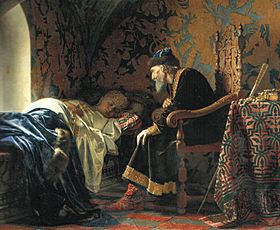Ivan the Terrible facts for kids
Quick facts for kids Ivan IV |
|||||
|---|---|---|---|---|---|
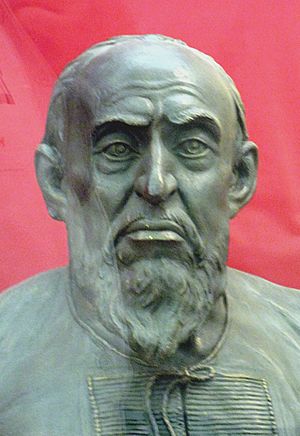
Forensic facial reconstruction of Ivan IV by Mikhail Gerasimov
|
|||||
| Tsar of Russia | |||||
| Reign | 16 January 1547 – 28 March 1584 | ||||
| Coronation | 16 January 1547 | ||||
| Predecessor | Monarchy established | ||||
| Successor | Feodor I | ||||
| Grand Prince of Moscow | |||||
| Reign | 3 December 1533 – 16 January 1547 | ||||
| Predecessor | Vasili III | ||||
| Successor | Himself as Tsar of Russia | ||||
| Born | 25 August 1530 Kolomenskoye, Grand Duchy of Moscow |
||||
| Died | 28 March [O.S. 18 March] 1584 (aged 53) Moscow, Tsardom of Russia |
||||
| Burial | Cathedral of the Archangel, Moscow | ||||
| Spouses |
See list
Anastasia Romanovna
Maria Temryukovna Marfa Sobakina Anna Koltovskaya Anna Vasilchikova Vasilisa Melentyeva Maria Nagaya |
||||
| Issue more... |
See list
|
||||
|
|||||
| Dynasty | Rurik | ||||
| Father | Vasili III of Russia | ||||
| Mother | Elena Glinskaya | ||||
| Religion | Russian Orthodox | ||||
Ivan IV Vasilyevich (25 August 1530 – 28 March [O.S. 18 March] 1584), commonly known as Ivan the Terrible (, Ivan Grozny; "Ivan the Formidable" or "Ivan the Fearsome"), was the Grand Prince of Moscow from 1533 to 1547 and the first Tsar of Russia from 1547 to 1584.
Ivan was the crown prince of Vasili III, the Rurikid ruler of the Grand Duchy of Moscow, and was appointed Grand Prince at three years-old after his father's death. Ivan was proclaimed Tsar (Emperor) of All Rus' in 1547 at the age of seventeen, establishing the Tsardom of Russia with Moscow as the predominant state.
Ivan's reign was characterized by Russia's transformation from a medieval state into an empire under the Tsar, though at immense cost to its people and its broader, long-term economy. Ivan conquered the Khanates of Kazan, Astrakhan and Sibir, with Russia becoming a multiethnic and multicontinental state spanning approximately 4,050,000 km2 (1,560,000 sq mi), developing a bureaucracy to administer the new territories. Ivan triggered the Livonian War, which ravaged Russia and resulted in the loss of Livonia and Ingria, but allowed him to exercise greater autocratic control over Russia's nobility, which he violently purged in the Oprichnina.
Ivan was an able diplomat, a patron of arts and trade, and the founder of Russia's first publishing house, the Moscow Print Yard. Ivan was popular among Russia's commoners (see Ivan the Terrible in Russian folklore) except for the people of Novgorod and surrounding areas who were subject to the Massacre of Novgorod.
Historic sources present disparate accounts of Ivan's complex personality: he was described as intelligent and devout, but also prone to paranoia, rages, and episodic outbreaks of mental instability that increased with age. Ivan is popularly believed to have killed his eldest son and heir Ivan Ivanovich and the latter's unborn son during his outbursts, which left the politically ineffectual Feodor Ivanovich to inherit the throne, whose rule directly led to the end of the Rurikid dynasty and the beginning of the Time of Troubles.
Contents
Personal life
Marriages and children
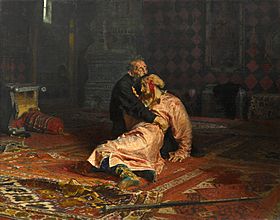
- Anastasia Romanovna (in 1547–1560, death):
- Tsarevna Anna Ivanovna (10 August 1548 – 20 July 1550)
- Tsarevna Maria Ivanovna (17 March 1551 – young)
- Tsarevich Dmitri Ivanovich (October 1552 – 26 June 1553)
- Tsarevich Ivan Ivanovich (28 March 1554 – 19 November 1581)
- Tsarevna Eudoxia Ivanovna (26 February 1556 – June 1558)
- Tsar Feodor I of Russia (31 May 1557 – 6 January 1598)
- Maria Temryukovna (in 1561–1569, death):
- Tsarevich Vasili Ivanovich (21 March 1563 – 3 May 1563)
- Marfa Sobakina (28 October – 13 November 1571, death)
- Anna Koltovskaya (in 1572, sent to monastery). This was the last of his church-authorized weddings. She was later canonized as Saint Daria.
- Anna Vasilchikova (in 1575/76, sent to monastery)
- Vasilisa Melentyeva (concubine in 1575 ?). Possibly fictitious, a 19th-century creation; his other "wife" Maria Dolgorukaya (1573) is fictitious.
- Maria Nagaya (since 1580), widow:
- Tsarevich Dmitri Ivanovich (19 October 1582 – 15 May 1591)
Religion
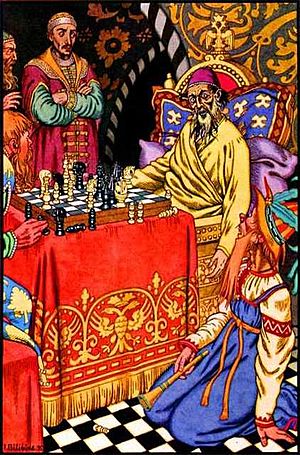
Ivan was a devoted follower of Christian Orthodoxy and placed the most emphasis on defending the divine right of the ruler to unlimited power under God. Some scholars explain the sadistic and brutal deeds of Ivan the Terrible with the religious concepts of the 16th century. In Ivan's view, the ruler was God's representative on Earth with a sacred right and duty to punish. He may also have been inspired by the model of Archangel Michael with the idea of divine punishment.
Death
Ivan died from a stroke while playing chess with Bogdan Belsky on 28 March [O.S. 18 March] 1584. Upon Ivan's death, the Russian throne was left to his unfit middle son Feodor. Feodor died childless in 1598, ushering in the Time of Troubles.
Appearance
Little is known about Ivan's appearance, as virtually all existing portraits were made after his death and contain uncertain amounts of artist's impression. In 1567, ambassador Daniel Prinz von Buchau described Ivan as follows: "He is tall, stout and full of energy. His eyes are big, observing and restless. His beard is reddish-black, long and thick, but most other hairs on his head are shaved off according to the Russian habits of the time".
According to Ivan Katyryov-Rostovsky, the son-in-law of Michael I of Russia, Ivan had an unpleasant face, with a long and crooked nose. He was tall and athletically built, with broad shoulders and narrow waist.
In 1963, the graves of Ivan and his sons were excavated and examined by Soviet scientists. Chemical and structural analysis of his remains disproved earlier suggestions that Ivan was poisoned by arsenic. At the time of his death he was 178 cm tall and weighed 85–90 kg. His body was rather asymmetrical and had a large amount of osteophytes uncharacteristic of his age; it also contained excessive concentration of mercury. Researchers concluded that while Ivan was athletically built in his youth, in his last years he had developed various bone diseases and could barely move. They attributed the high mercury content in his body to the use of ointments for joints healing.
Legacy
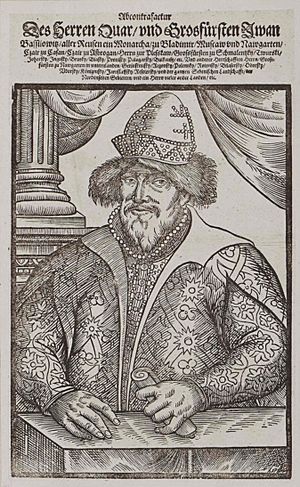
Ivan completely altered Russia's governmental structure, establishing the character of modern Russian political organisation. Ivan's creation of the Oprichnina, answerable only to him, not only afforded him personal protection but curtailed the traditional powers and rights of the boyars. Henceforth, Tsarist autocracy and despotism would lie at the heart of the Russian state. Ivan bypassed the Mestnichestvo system and offered positions of power to his supporters among the minor gentry. The Empire's local administration combined both locally and centrally appointed officials; the system proved durable and practical, and sufficiently flexible to tolerate later modification.
Ivan's expedition against Poland failed at a military level, but it helped extend Russia's trade, political and cultural links with Europe; Peter the Great built on these connections in his bid to make Russia a major European power. At Ivan's death, the empire encompassed the Caspian to the southwest, and Western Siberia to the east. Southwards, his conquests ignited several conflicts with expansionist Turkey, whose territories were thus confined to the Balkans and the Black Sea regions.
Ivan's management of Russia's economy proved disastrous, both in his lifetime and after. He had inherited a government in debt, and in an effort to raise more revenue for his expansionist wars, he instituted a series of increasingly unpopular and burdensome taxes. Successive wars drained Russia of manpower and resources, bringing it "to the brink of ruin". After Ivan's death, his empire's nearly ruined economy contributed to the decline of his own Rurik Dynasty, leading to the "Time of Troubles".
Ivan's notorious outbursts and autocratic whims helped characterise the position of Tsar as one accountable to no earthly authority, only to God. Tsarist absolutism faced few serious challenges until the late 19th century. Ivan's legacy was manipulated by Communist Russia as a potential focus for nationalist pride; his image became closely associated with the personality cult of Joseph Stalin. While early Soviet, Marxist–Leninist historiography "attached greater significance to socio-economic forces than to political history and the role of individuals", Stalin wanted official historians to make Russia's history "comprehensible and accessible" to the populace, with an emphasis on those "great men", such as Ivan, Alexander Nevsky and Peter the Great, who had strengthened and expanded the Russian state. In modern, post-Soviet Russia, a campaign has been run to seek the granting of sainthood to Ivan IV; the Russian Orthodox Church opposed the idea.
Popular culture
- The Soviet filmmaker Sergei Eisenstein made two films based on Ivan's life and reign, Ivan the Terrible. The first part is about Ivan's early years. The second covers the period of his maturity. A third was planned but never completed.
- Conrad Veidt portrayed Ivan the Terrible in Paul Leni's film Waxworks.
- Tsar – a 2009 Russian drama film directed by Pavel Lungin.
- In the film Night at the Museum: Battle of the Smithsonian Ivan was played by Christopher Guest.
- Russka (1991) the novel by Edward Rutherfurd
- Ivan the Terrible is a major character in the Soviet era fiction comedy Ivan Vasilievich: Back to the Future, based on a play by Mikhail Bulgakov. It was one of the most popular films in the Soviet Union in 1973 and sold more than 60 million tickets.
- Ivan appears as a major character in the novel The Ringed Castle (1971), fifth of the six novels in Dorothy Dunnett's historical fiction series, the Lymond Chronicles.
- Ivan the Terrible is one of the playable teams in Age Of Empires III
- Ivan was portrayed on BBC Radio 4 by David Threlfall in the radio play Ivan the Terrible: Absolute Power, written by Mike Walker and which was the first play in the first series of Tsar. The play was broadcast on 11 September 2016.
Images for kids
-
Portrait of Ivan IV by Viktor Vasnetsov, 1897 (Tretyakov Gallery, Moscow)
-
The Oprichniki by Nikolai Nevrev (1888). The painting shows the last minutes of boyarin Feodorov, who was arrested for treason. To mock his alleged ambitions on the tsar's title, the nobleman was given tsar's regalia before his execution.
-
Ivan the Terrible Showing His Treasures to Jerome Horsey by Alexander Litovchenko (1875)
-
Ioannes Basilius Magnus Imperator Russiae, Dux Moscoviae, by Abraham Ortelius (1574)
See also
 In Spanish: Iván IV de Rusia para niños
In Spanish: Iván IV de Rusia para niños


